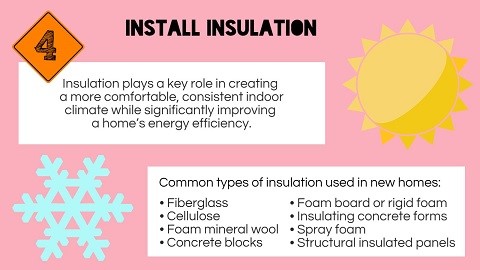This is Part 4 of our custom home building process guide. This guide was originally written by Susan Bady for newhomesource.com.

- Install insulation: Insulation plays a key role in creating a more comfortable, consistent indoor climate while significantly improving a home’s energy efficiency. One of the most important qualities of insulation is its thermal performance or R-value, which indicates how well the material resists heat transfer. Most homes are insulated in all exterior walls, as well as the attic and any floors that are located above unfinished basements or crawl spaces.
The most common types of insulation used in new homes are fiberglass, cellulose and foam. Depending on the region and climate, your builder may also use mineral wool (otherwise known as rock wool or slag wool); concrete blocks; foam board or rigid foam; insulating concrete forms (ICFs); sprayed foam; and structural insulated panels (SIPs).
Blanket insulation, which comes in batts or rolls, is typical in new-home construction. So is loose-fill and blown-in insulation, which is made of fiberglass, cellulose or mineral-wool particles. Another insulation option, liquid foam, can be sprayed, foamed-in-place, injected or poured. While it costs more than traditional batt insulation, liquid foam has twice the R-value per inch and can fill the smallest cavities, creating an effective air barrier.
Fiberglass and mineral-wool batts and rolls are usually installed in side walls, attics, floors, crawl spaces, cathedral ceilings and basements. Manufacturers often attach a facing such as kraft paper or foil-kraft paper to act as a vapor barrier and/or air barrier. In areas where the insulation will be left exposed, such as basement walls, the batts sometimes have a special flame-resistant facing.



